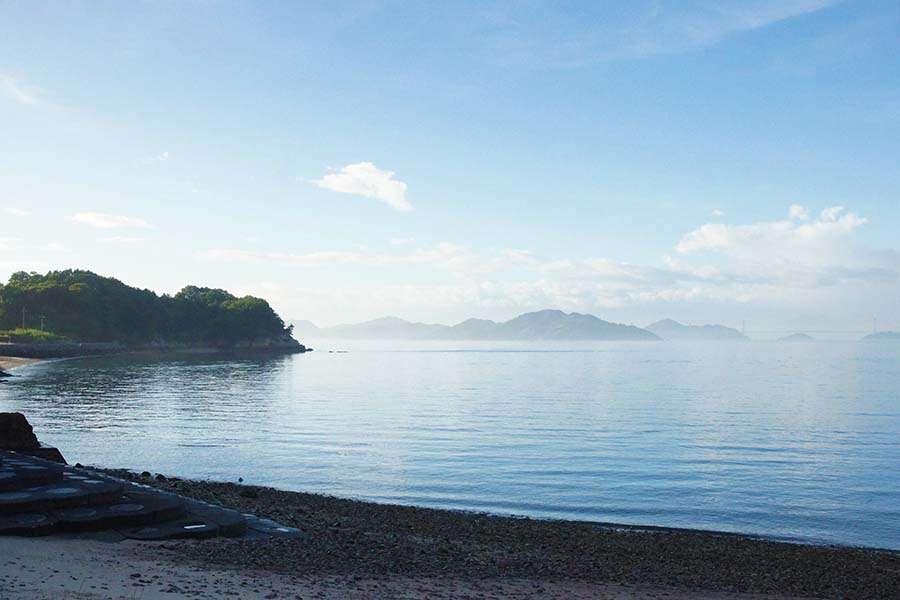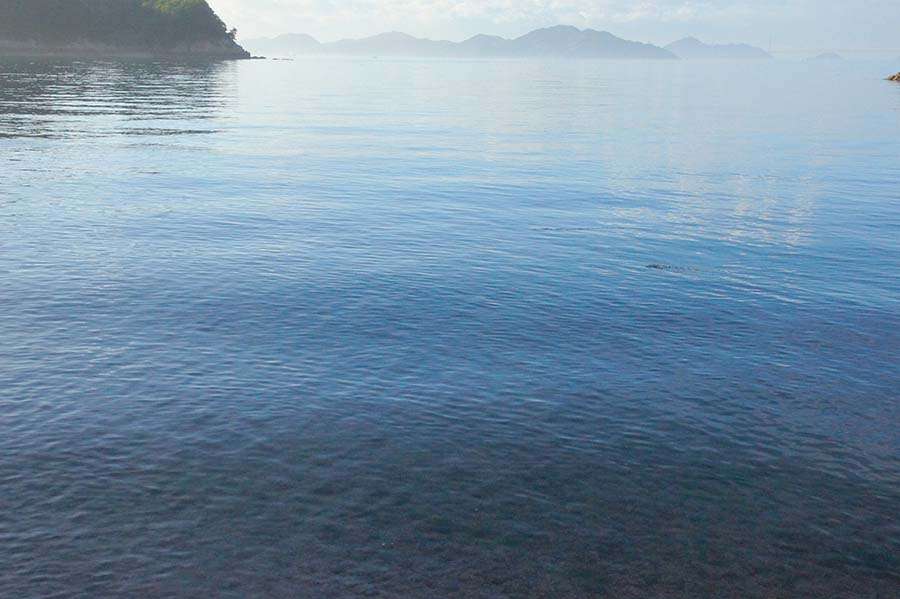
Omishima; an island full of natural beauty but no job opportunities
The Pritzker Architecture Prize-laureate, Toyo Ito, is heavily invested in a small yet beautiful island called Omishima. It is located in the middle of the Seto Naikai Inland Sea in Western Japan, an area rich in history and natural heritage. Like many other islands in the Seto Naikai, Omishima has enigmatic charm, but suffers from a declining population due to a lack of major industries and investment. About 5,900 people live on the island today, and young people are leaving because there aren’t enough jobs. Toyo Ito and his NPO are engaged in various projects in Omishima so that it can re-discover/re-brand its beauty to create new opportunities. One project is happening at the 大三島 憩の家 (Omishima Ikoi-no-Ie), one of the few visitor accommodations available on the island, located in the southwestern point of the Munagata district.
The Munagata district has been experiencing a decreasing population despite its almost heavenly beach. The local elementary school had to close its doors in 1986 after more than 100 years of history because the community no longer had enough children to keep it open.
The Omishima Ikoi-no-Ie is a redevelopment of the former school facilities using buildings that are believed to be about 80 years old. The site has small hills to its rear and a breathtakingly beautiful beach in front. Notice how blue and calm it is.
But children are always a community’s future, and schools have a special place in people’s hearts. Instead of demolition, local people have kept the facilities and converted them into accommodation. The current owner, the Fujiwara family, acquired the place about 20 years ago, and has been operating it as the “大三島 憩の家 (Omishima Ikoi-no-Ie), a B&B&D (not just bed and breakfast, they also serve dinner) ever since. Ikoi-no-Ie means “a place where you can feel at home and relax.”
The Ikoi-no-Ie is run by the Fujiwara family – Daisei Fujiwara, husband and the owner/chef, and his wife Mari Fujiwara (in the left picture). The couple have three children who go to school outside their community. There is only one other family with children in the district today, which obviously is not enough to keep this place as the school.
The Fujiwara family’s personal story is also the story of Omishima island. The Omishima-native Daisei Fujiwara, husband and the owner chef of the Ikoi-no-Ie, was born into a family that has been operating one of the few and oldest ryokan (traditional Japanese style hotel) on the island. It is called “Chaume” and is near the Oyamazumi Shrine, a landmark and tourist destination. He left the island after he graduated from high school, worked for several years in restaurants/hotels in larger cities to prepare himself to join the family business.
Mari Fujiwara, his wife, was also born in Omishima. Her grandparents grew citrus trees like many of their neighbors. Her mother was a daycare teacher, and her father worked in multiple jobs. Like most of her fellow students, she went to a high school that was outside the island, and then left the island after graduation. After several years of working in cities, she came back when she married to Daisei Fujiwara.
Omishima is blessed with a mild, relatively dry Mediterranean climate, but it lacks level land. People traditionally relied on terracing to grow citrus, especially tangerines. Mari Fujiwara recollects: “When I was a child, the entire hills would look orange in winter as they were covered with ripe tangerines.”
In the same way as Daisei and Mari Fujiwara, it has been a natural path for young people from Omishima to leave the island to live in urban areas to seek a better education, better job opportunities, and, just as important for youngsters, excitement. But after several years of exploring, some of them – or maybe many of them – decide that they want to come home. But the question always comes back to the same one: there are not enough jobs for young people. Back in the old days, many people, like Mari’s grandparents grew tangerines. But as the market became difficult for small-scale farmers, the younger generation started opting out of the tangerine growing tradition. Today many orchards are simply abandoned because the current owners are too old to take care of them, and no one is taking over the task.
The Fujiwaras were able to come back because they had a family business. But many others end up living in other places, despite their wish to return. The imbalance between a beautiful living environment with a mild climate and the total lack of job opportunities is a serious problem for the future of the island. That’s why Toyo Ito and his team stepped in: they see that the environment and the way local communities preserve their heritage and tradition are truly unique and beautiful, and need to be reinvigorated and passed onto the next generation.
The Ikoi-no-Ie Renovation Project and Toyo Ito’s Omishima Lifestyle Laboratory
The Fujiwaras might have been fortunate to be able to come back to Omishima, but maintaining the 80 year-old wooden buildings was far from an easy job. Not only is wear and tear rapid (the humid and rainy climate makes timbers susceptible to mold and decay), but they also attract termites. In addition, the buildings are inefficient in terms of insulation and protection against harsh weather. Finally, wooden structures are more prone to fire and earthquakes which often happen in Japan. According to Mari Fujiwara, the Ikoi-no-Ie started to experience maintenance problems and they were getting overwhelmed.
Japanese architecture has historically relied on wood and people built everything using timber. Although wooden buildings age uniquely and beautifully, they require frequent maintenance.
Ikoi-no-Ie happened to be sitting right next to the “Ken Iwata Mother and Child Museum, Imabari City,” a museum designed by Toyo Ito. Coincidentally, it opened in 2011, the same year as the Toyo Ito Museum of Architecture, Imabari (TIMA) opened on the same coast, just 5 minute drive away. Naturally, Ito and his team often used the Ikoi-no-Ie, and the Fujiwara’s got to know them. At some point the Fujiwaras sought professional advice from Ito’s team about the maintenance of the building and a potential renovation. Then the City of Imabari, which operates the TIMA, suggested that they apply for local community revitalization funds provided by the Cabinet Office to carry out a full-fledged renovation. With Ito’s support, the project was selected.
Left: The Toyo Ito Museum of Architecture, Imabari. It shares the same coast with the Ikoi-no-Ie, and is only a 5 minute drive away.
Right: Toyo Ito at the Ikoi-no-Ie. June, 2018
“It was a pivotal moment for us,” Mari recounts of the renovation. “We could have given up the place because the building maintenance was getting out of hand. We were so fortunate to know a renowned architect like Toyo Ito and get help from his team. We now have charming rooms and proper facilities.” It is the Omishima Lifestyle Laboratory which is part of Toyo Ito’s NPO “Initiative for Tomorrow’s Opportunities in architecture (ITO)” that played central part in the project.
The old library on the second floor. It has been kept almost as it was, including the books read by the students and the student chairs. The room also displays photos of the renovation process.
Ito’s NPO, the “Omishima Lifestyle Laboratory,” led the renovation of the room 1-1 (the former 1st grade classfroom), offering professional resources. For example, the furniture was designed and made, and walls were finished by professional members. “But we tried to leave the old details as far as possible,” one of the team members told me. “Ito always reminded the team that the beauty of this place had to be linked to its history as an old elementary school.”
The renovated rooms are really charming, but the meals are also great at the Ikoi-no-Ie. One of the reasons why it offers dinner is probably because there are no other restaurants in the area, but it is a bliss to be able to be secluded in this peaceful place and enjoy great food, completely forgetting about about busy, fast-paced urban life. Reflecting the rich natural environment, you will enjoy many unique ingredients including seafood and vegetables.
Above: The dining room was also renovated. The chairs were designed by a renowned furniture designer Taiji Fujimori.
Below: Daisei Fujiwara, the owner chef, prepares delicious meals leveraging locally harvested vegetables and seafood.
Left: breakfast. Right: The sashimi plate from dinner.
Mari continues: “Since I grew up here, I took the beauty of this island for granted – it was just a normal part of my life.” But when she started the Ikoi-no-Ie and heard people say how special this place was, she came to realize that she was surrounded by something totally unique and priceless. There is no Starbucks, no restaurants, and not even an elementary school. “There is nothing here,” she continues, “but this is such a rich place. I’ve come to appreciate the abundance of having nothing.”
One of the traditional features of Japanese architecture is the “engawa,” the long hallway strips that are exposed to outside. At school, it was typically called a “rouka.” It connected classrooms (right hand side in the picture above) with the outside. Students would play outside, wash their hands, take off their shoes and come back inside the classroom.
For modern tourism, accommodation is required to be “sanitized” as if no one has stayed in the room before. But at the Ikoi-no-Ie, you can still sense the laughter of kids and see signs of their presence that are over 30 years old. It really fills and warms your heart.
The place was featured in a movie produced in 2002 and released in 2003. The bottom picture shows the sign commemorating the filming.
The renovation project was completed and the facility re-opened in April, 2018. But the Ikoi-no-Ie keeps evolving. Working with Ito’s Omishima Lifestyle Laboratory, the Fujiwaras are planning on adding more facilities and utilities in coming years. Ito is hoping to make this place a “vibrant networking hub for the area.”





































































